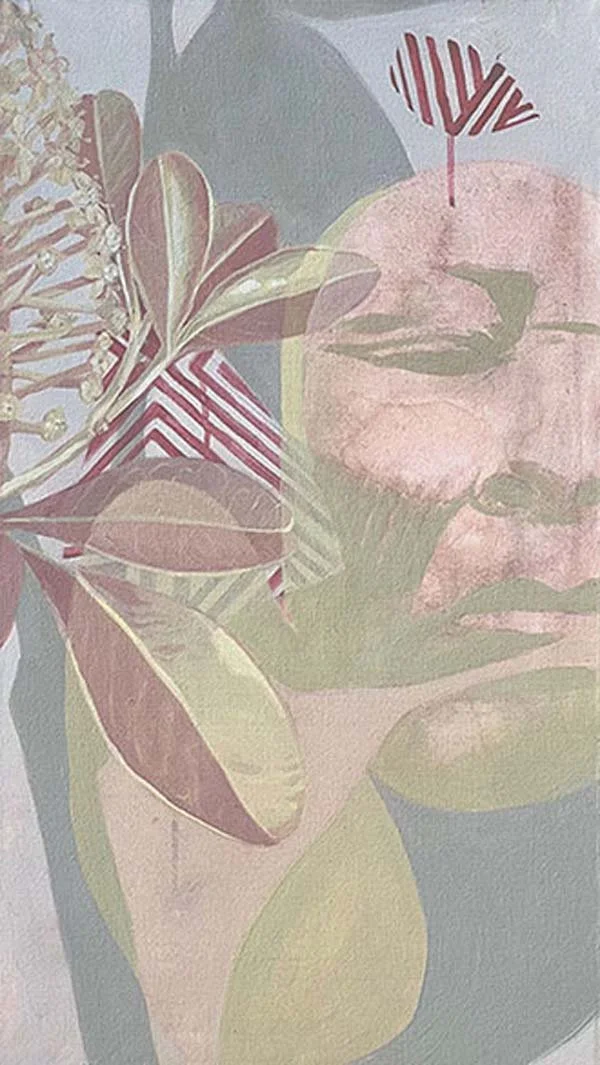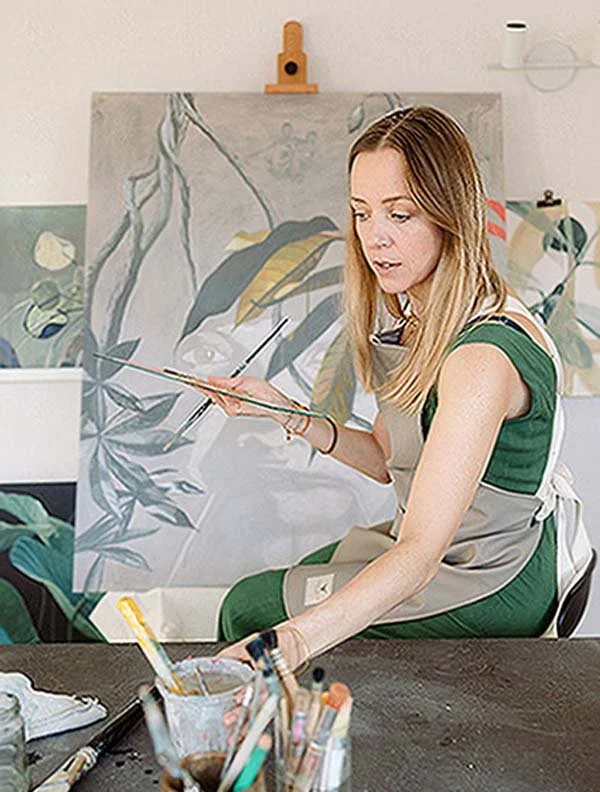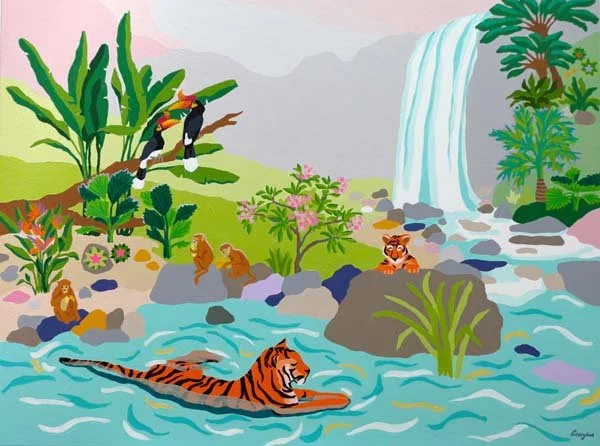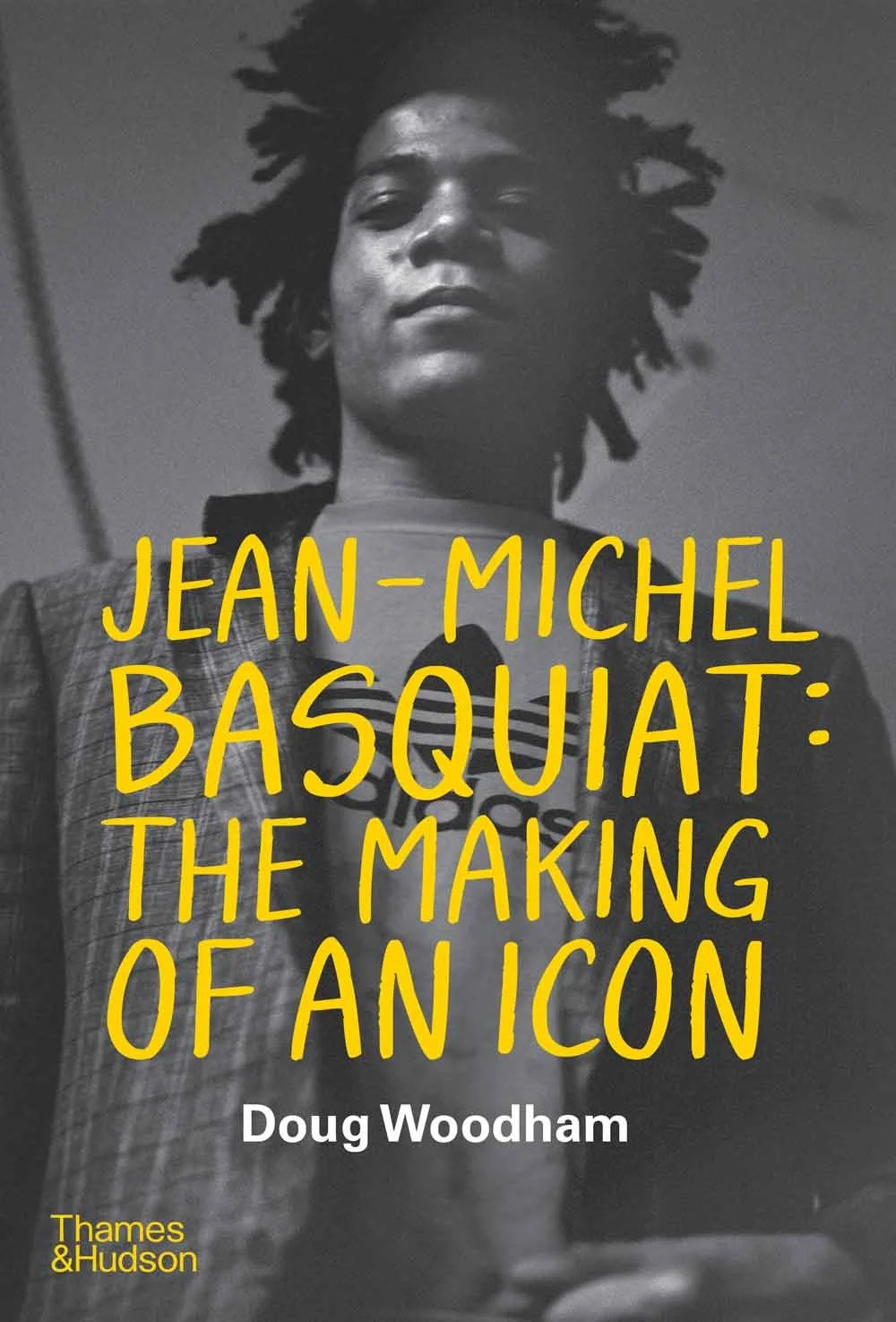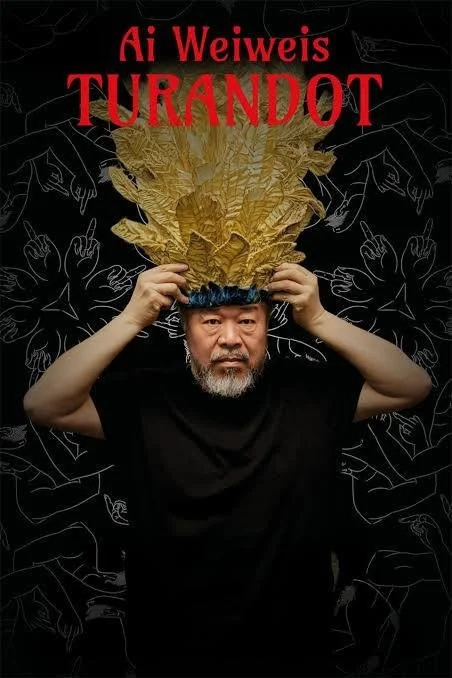Clarissa P. Valaeys is a Brazilian-born artist based in Geneva who returned to her passion for painting and drawing after a 20-year career as an art director in advertising and design. Educated at the School of Visual Arts and Cooper Union in New York City, she worked with prestigious brands like Rolex and Chopard in Europe. During the pandemic, she rekindled her connection to her Brazilian roots through art, focusing on nature, native peoples, and ecological preservation. A certified yoga teacher, Clarissa integrates mindfulness and creativity in workshops at her studio, sharing a healing and grounding artistic practice. @clarissa_valaeys
Where were you born and raised? How has that early environment shaped the themes and emotions in your art today? I was born in Southern Brazil, surrounded by nature’s beauty. Growing up in this environment deeply influenced my art, as I’ve always been drawn to organic forms and the energy of the natural world. Brazil’s rich indigenous heritage also shaped my thinking about sustainability and the importance of preserving our planet.
Having lived abroad for 25 years in four different countries, my art has become a way for me to reconnect with my roots. Through my work I honor nature and the wisdom of indigenous cultures, while also reminding myself of the environment I grew up in and the values I hold dear.
Although you trained and built a career in graphic design and art direction, what finally inspired you to embrace fine art? I probably started drawing before I could even speak. Art was always my safe space, I would spend hours lost in imaginary worlds, sketching freely and letting my curiosity guide me. But growing up, I wasn’t really encouraged to pursue it professionally, so I chose a more "secure" creative path and went to design school. That eventually led me to a successful career as an art director when I moved to New York in 2000.
Even though I stepped away from fine art for a while, it never left me. In fact, coming back to it after many years has been incredibly healing. For me, art has been essential to my mental health and well-being, it’s helped me reconnect with my purpose, with nature, and with a more intuitive, present way of being. It allows me to express how I perceive and admire the natural world, and to communicate its importance. We often forget that we are nature, art is my way of reminding myself and others of that truth.
Can you describe your studio routine? Walk us through your studio and your most used materials and tools. My day always begins with movement, whether it’s yoga, dancing, meditation, or walking my dog. It’s my way of getting the energy flowing before I settle into my studio to continue with whatever project is calling for my attention. It could be a painting for an upcoming show, a commission, an illustration for a brand or editorial piece, or even planning a workshop.
Lately, I’ve been working a lot with acrylics and ink. I love how flexible and freeing they are, they really mirror the fluid, intuitive approach I bring to my work and state of mind. No two days are ever the same, and I’ve learned to honor that. I listen to how I feel and adapt my rhythm depending on my energy.
In my previous career, especially during my years in New York, productivity often came at the cost of my health and even time with my family. Now, I’ve chosen a different path, one where I have the freedom to decide what’s most important each day. It’s true that I no longer have the comfort of a fixed salary at the end of the month, but I’ve made peace with that. I trust that I’ll make enough to live a life driven by passion, purpose, and balance.
What projects are you at work on at the moment? How do these different projects reflect your evolving relationship with nature and your cultural roots? At the moment, I’m preparing for a solo show during Un Soir aux Eaux-Vives, a beautiful annual event here in Geneva, Swittzerland. I feel so grateful to have been selected. The show is called "Spirits of the Forest", and it’s a tribute to sacred plants and their consciousness, a way of honoring their presence, beauty, and the spiritual knowledge they carry. These pieces reflect my deepening exploration of how nature can guide and inspire us when we slow down and truly listen.
I’ve also recently been commissioned to write and illustrate a book about gardening, a new and exciting challenge that allows me to combine my love of plants, storytelling, and visual expression.
Another major project on the horizon is my solo exhibition at the Meise Botanical Garden in Belgium in 2026. It’s a dream opportunity to continue my botanical explorations on a large scale and to deepen the conversation between art, science, and nature.
In parallel, I’m planning a research trip to Brazil, where I hope to reconnect with the biodiversity of my roots, learn from indigenous communities, and better understand the environmental challenges affecting the region. This experience will be key in shaping future works and continuing my mission to inspire more reverence for the natural world.
When people engage with your paintings, what kind of emotional or spiritual connection do you hope to awaken in them? I hope each person who experiences my art feels something personal — a sense of connection, whether it’s with nature, with themselves, or even with a memory or feeling they hadn’t thought about in a while. My aim isn’t to dictate an emotion but to create space for reflection, presence, and maybe even wonder.
What I’m really trying to express is the deep gratitude and respect I feel when I’m painting these plants and honoring their stewards. I know I can never fully capture the beauty and richness of nature, but if my work can translate even a fragment of how I see and feel it, then that’s my small way of giving back, a gesture of thanks for everything Mother Earth gives us, every single day.
Which artists, historical or contemporary, would you like to meet? There are so many artists I’d love to meet, across time and disciplines. Henri Rousseau, for one, I’ve always been drawn to his dreamlike jungle scenes and how he portrayed nature with such imagination, even though he never traveled to those places. I’d be fascinated to hear about his creative process and inner world.
I also deeply admire the technical mastery of Gerhard Richter and Chuck Close, their ability to move between photorealism and abstraction is just breathtaking. Their work feels like a meditation on perception and detail.
And then there’s Ron Mueck... his sculptures absolutely blow my mind. The realism, the scale, the emotion, I honestly don’t know how it’s even possible. I’d love to just stand in his studio and watch the magic happen.
Beyond visual art, what other elements in your life—music, movement, or something else—fuel your creative energy and affect your work? I draw inspiration from life itself. My creative state is closely tied to how I’m feeling. When I was in a more somber place, my paintings were moodier, darker, and much more detailed. These days, I’m embracing imperfection and allowing more spontaneity into my work. I let things happen, the way a color dries unevenly, or how a stray drop leaves a mark on the canvas. It’s all part of the process now.
The pace of my painting is often influenced by the music or podcast I have on in the studio. And then there’s my dog, a constant companion who pulls me away from my canvas and into nature several times a day, and those little pauses help me recharge and reconnect.
I’m also fueled by visual experiences, museums, galleries, flea markets, photography, landscapes, architecture. Beauty in all its forms inspires me deeply. I’m a Libra sun, after all, so that probably says it all!
A great thing about living in Geneva is…
that it’s international and diverse, big enough to be stimulating, but not overwhelming. I feel at home here for now, even though I don’t feel like I have a permanent home anymore. Geneva is a beautiful compromise between the places that have shaped me: Brazil, New York, and rural France.
Nature here is stunning, and my studio overlooks the lake, which is a daily source of peace and inspiration. Honestly, I can’t complain, it’s a place that offers both serenity and creative energy, which is all I really need.
Reflecting on your journey, can you share a moment or project that pushed you creatively or emotionally, and how you found your way through that challenge? Last year, I co-created a book with the Danish publisher Snap Collective, and it was a creatively and emotionally intense process, especially given the tight timeline. Revisiting all my work from the past four years pushed me to reflect deeply on my evolution and reconnect with my "why" as an artist.
Because I started my journey as a full-time artist later in life, I feel like I’m moving through creative phases more quickly, there’s a certain urgency, a desire not to waste time. That project helped me appreciate the work I’ve created so far, and also gave me permission to let go, to grow, and move on to something new with a sense of gratitude and clarity.
Tell us about important teachers and mentors. How have these relationships shaped your artistic voice and vision? I can’t not mention Miss Sandra, my kindergarten teacher, she already knew I was an artist back then. And of course, my mom, who always encouraged me to draw, dance, and follow anything creative. That early support meant everything.
Later on, during college in Brazil, I had an incredible teacher/mentor, Marina Willer, who left a lasting impression on me. She had this spark in her eye that made you believe it was not only possible to make a living as a creative, but to enjoy the ride too. Today, she’s a partner at Pentagram London, one of my favorite design firms. Her work is incredible! I'm a huge fan.
Another unforgettable mentor was Milton Glaser, the legendary designer behind the “I ♥ NY” logo. I took a class with him at the School of Visual Arts in New York, and what struck me most was that he never judged our work. Instead, he taught us how to think for ourselves. That experience changed the way I looked at my art forever.
Because I come from a background in graphic design and art direction, my paintings often carry a sense of storytelling, composition, and color that I learned through years of creative direction. I sometimes joke, “The worst thing that happened to me as an artist was being a graphic designer”, but honestly, it shaped my visual language in ways I’m deeply grateful for.
Nature plays a central role in your art and life. Can you share a memory or insight about how reconnecting with the natural world has impacted your creative process and personal well-being? During the confinement in 2020, I found solace in nature. I was still working full-time as a creative director, constantly on Zoom calls, often on projects that no longer challenged or fulfilled me. I started taking the kids on daily walks by the river, it became our ritual, a way to escape the screens and breathe again. Those walks saved me.
That period was a turning point. I hit emotional and physical rock bottom. I was suffering from a chronic illness that forced me to reevaluate everything. Eventually, I healed, not just physically, but spiritually, by drastically changing how I lived, how I worked, and how I cared for myself.
Reconnecting with myself led to a deeper, more sacred connection with nature. I no longer see a division between us and the earth, when we neglect our bodies, our minds, and our emotional health, we also lose our sensitivity to what’s happening around us. This realization has profoundly influenced my work.
Nature speaks to me in ways I didn’t understand before. Through meditation, dreams, my studio plants, the rhythm of animals and water, I’ve learned to listen. And I try to translate that into my art, as a form of devotion and reciprocity.
I’m also in the early stages of creating a movement with a writer friend that links art and nature in a deeper way. I often say I want to say goodbye to my creative direction days, but they’ve never really left me. The difference now is that I choose projects that align with my values, projects that come from the heart.
With the rise of AI and digital tools reshaping creativity, how do you view the relationship between technology and traditional, handmade art in your own practice? AI is undeniably transforming the creative landscape, it’s reshaping how we communicate, make images, share stories, and even how we define beauty. It’s both fascinating and a little unsettling. As someone who creates with their hands, who values the slowness of the process, the unpredictability of paint, the emotion in a brushstroke, I feel a deep reverence for the handmade in a world that’s becoming more digitized by the minute.
Technology can be a powerful tool, especially in helping us reach more people, tell stories, and support causes that matter. But I believe human art, the one made through time, presence, and emotion, holds something irreplaceable. You can feel the breath of the artist in it, the imperfections, the history in each layer. That kind of energy simply can’t be replicated by a machine.
To me, art is about connection and consciousness. It’s about slowing down in a world that keeps speeding up. It’s a meditation, a protest, a form of healing. While I remain curious and open to how technology might complement or expand creativity, I will always admire the magic of handmade work.
Exploring ideas, art and the creative process connects me to…
the deepest parts of myself. It awakens my curiosity, gives me a strong sense of purpose, and fulfills me immensely. It's where I feel most alive, most aligned, and most connected to something greater than myself.




